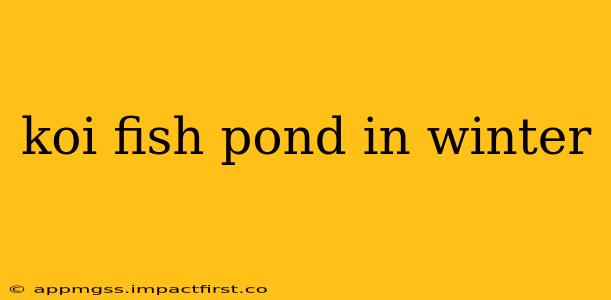Winter presents unique challenges for koi pond owners. The plummeting temperatures, ice formation, and reduced sunlight can significantly impact the health and well-being of your beloved koi. This comprehensive guide will cover essential aspects of winter koi pond care, ensuring your fish thrive even during the coldest months. We'll address common concerns and provide practical solutions to help you navigate the winter season successfully.
How Cold Is Too Cold for Koi Fish?
Koi are surprisingly hardy fish, but their tolerance for cold depends on several factors including the fish's acclimation, the overall pond environment, and the specific koi species. Generally, koi can tolerate temperatures down to around 40°F (4°C) for short periods. However, prolonged exposure to temperatures below this threshold can lead to hypothermia and potentially death. Consistent temperatures below 40°F necessitate active intervention to protect your fish.
What Happens to Koi Fish in Winter?
As water temperatures drop, koi's metabolism slows down significantly. They become less active, feeding less frequently, and requiring less oxygen. This natural slowing of processes is crucial to understand when planning your winter pond maintenance. Their immune systems also weaken, making them more susceptible to disease. Understanding these changes is vital to providing adequate care.
How to Protect Koi Fish from Freezing Temperatures?
Protecting your koi from freezing temperatures is paramount. Several strategies can be employed, depending on your pond's size and your climate.
Pond Depth:
A deeper pond naturally retains more heat than a shallow one. Aim for a minimum depth of at least 4 feet (1.2 meters) to help buffer against extreme temperature fluctuations.
Water Circulation:
Maintaining some water movement, even in winter, helps prevent ice formation and ensures oxygen distribution. An air pump or a de-icer can prevent the pond from completely freezing over.
Pond De-icers:
Pond de-icers are devices that keep a small hole open in the ice, allowing for gas exchange and preventing a complete oxygen depletion. These are particularly useful in areas with severe winters.
Pond Covers:
Insulating your pond with a floating cover can help maintain a higher water temperature, reducing the impact of cold air. However, ensure adequate gas exchange to prevent oxygen depletion.
Adding Heaters:
In extremely cold climates, submerged pond heaters might be necessary. Choose appropriately sized heaters for your pond volume and monitor the temperature carefully.
What Do Koi Fish Eat in Winter?
Koi's feeding requirements drastically reduce in winter. Their metabolism slows, and they require significantly less food. Overfeeding in winter can lead to uneaten food decomposing in the pond, causing harmful ammonia buildup. Reduce feeding frequency, providing only small amounts of high-quality koi food every few days, or even ceasing feeding altogether in exceptionally cold conditions. Observe your koi; if they are not actively seeking food, they don't need to be fed.
Do Koi Fish Hibernate in Winter?
While koi don't truly hibernate like some other animals, they become significantly less active and their metabolic rate slows considerably. This period of reduced activity is often referred to as a state of torpor. They are still awake and responsive, but their needs are substantially reduced.
How to Winterize a Koi Pond?
Winterizing your koi pond involves several key steps:
- Clean the pond: Remove excess leaves, debris, and decaying organic matter before winter arrives.
- Check equipment: Ensure all pumps, filters, and heaters are functioning correctly.
- Reduce feeding: Decrease the frequency and amount of food.
- Monitor water levels: Ensure the pond is at the appropriate water level.
- Install de-icers or covers (as needed): Protect your pond from freezing temperatures.
- Test water quality: Monitor ammonia, nitrite, and nitrate levels throughout the winter.
By carefully following these guidelines, you can ensure your koi survive the winter and emerge healthy and vibrant in the spring. Remember to adapt these recommendations to your specific climate and pond setup. Regular observation of your koi and your pond environment is crucial for their well-being throughout the winter months.
